OK, so you're seawatching and feeling optimistic. A large Cory's-type shearwater appears at reasonable range: how are you going to be best clued-up on assessing its potential as a Scopoli's Shearwater? As it happens, I was in the middle of a fantastic movement of well over 1,000 Great Shearwaters off the north coast of Donegal on 19th August 2005 when, quite surprisingly, I began to pick up Cory's Shearwaters. It was only after I had seen about a dozen birds that I even thought to 'check' for features of Scopoli's. So much for being on the ball!
Actually, most of the 20 or so birds I saw subsequently flew like classic Atlantic Cory's and on the closest views, the underwing looked normal for nominate borealis. I also noticed how most of the time the upperwings looked essentially dark brown contrasting with a paler fawn or grey-brown area that covered the topside of the head, neck, mantle, scapulars and inner forewing. I then began to recall that the Scopoli's I had seen in the Mediterranean appeared to show a paler upperwing with a more conspicuous dark 'carpal' bar. I vowed to look up my notes once back home and be a bit more on the ball next time!
The prize of Scopoli's Shearwater has so far only been claimed 3 times off British waters (as far as I am aware), and once in Ireland, and has not yet been officially accepted onto a national list. This is not really surprising. Since Ricard Gutierrez opened up the potential of separating Cory's and Scopoli's in the field (see Dutch Birding 20: 5), the waters of identification have unfortunately become increasingly muddied. Some Cory's from Atlantic island populations show white on the inner webs of the primaries, which can be visible on the underside (e.g. see photo in Birding World 10: 228) though not as extensively as typical Scopoli's. It also seems certain that Cory's Shearwater occurs with some regularity in the Mediterranean, both wintering and occasionally in the breeding season (Gutierrez 1998).
Among movements of Scopoli's off Menorca I have seen birds that, to all intents and purposes, on both flight style and underwing pattern, I could not separate from Cory's. Further east in the Mediterranean, some of the birds seen off coastal waters off Israel look remarkably like the Cory's of the eastern Atlantic islands. Biometrics suggests they may indeed be Cory's (Gutierrez 1998, James Smith pers. com.). It may be that they have gone the 'wrong way' up the eastern coast of Africa and entered the Mediterranean via the Red Sea. Cory's are mostly reported wintering off South America, but some do winter off South Africa and could naturally therefore mimic their normal migration strategy and head up an eastern seaboard, except that is the African and not South American seaboard! It seems that a particular geographic location may not be a guarantee of the form of large Calonectris shearwater that will be encountered!
I like a nice clean fight when it comes to identification challenges, but this group of big shearwaters is making it hard work! Nevertheless, perseverance can bring breakthrough, and I reckon you will always LEARN something useful anyway.
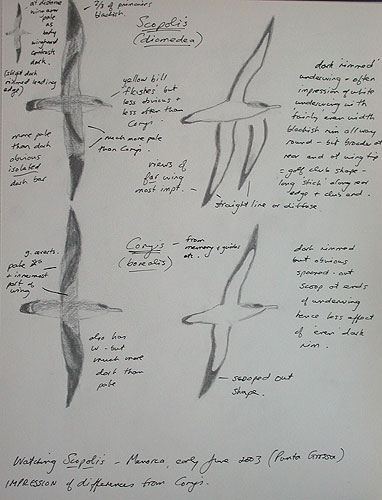 |
| (Atlantic) Cory's Shearwater and Scopoli's Shearwater: (sketch: Martin Garner). |
So, here I will take the risk of sharing some suggestions for furthering the identification progress of these birds, aware that not all are convinced that they can be separated confidently away from natal areas.
Despite the paucity of claims in British and Irish waters, Scopoli's Shearwaters seem to make it regularly into the coastal waters of North America and winter as far as South Africa, so such a pelagic wanderer should clearly be expected to occur more often around our coasts. A door may have opened up during this autumn seawatch season to advance the identification of these birds and re-evaluate their likelihood of occurrence off Britain and Ireland, which will be reported later.
What I will attempt to do here is to focus on key 'go for' features so you can be more on the ball than I was in August! As well as reading the key papers I have been fortunate enough to see 100s of Cory's in Britain, Ireland and off the Canaries and literally 1000s of Scopoli's in the Mediterranean (including one amazing movement of nearly 10,000 Scopoli's off Punta Nati in northwest Menorca). From these observations I would like to lay out the potential differences, but with the caveat that we are still on a steep learning curve with these tubenoses.
These are my top three 'go-for' characters, which are mainly a regurgitation of my field notes:
1. Underwing pattern
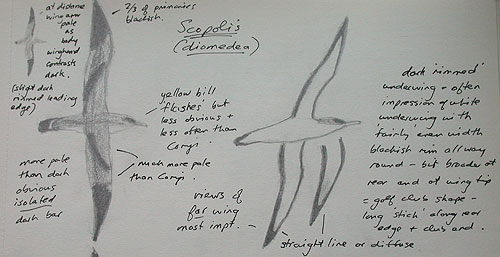 |
| Scopoli's Shearwater: (sketch: Martin Garner). |
It's not always easy to see the underwing pattern on Scopoli's by any means. Upperwing pattern is often more visible as many birds keep low, with more regular flapping than Cory's. When underwing becomes visible, first impression is of what I would describe as 'golf club' dimension to the pattern of black. With the long, dark trailing edge of wing as the club shaft, which ends in a dark 'club' at the tips of the primaries. The dark trailing edge seems to be a little thinner than on Cory's and dark leading edge can be particularly thin. The overall impression is of a bright whitish underwing with a thin dark rim. On Cory's, where dark (of primaries) meets white (of underwing coverts) there is clear divide that produces 'scooped-out-by-a-spoon' shape. However, on Scopoli's, where the dark pattern on the underside of the primaries meets white it looks in flight like it is squared or cut-off. Sometimes the cut-off point looks clear-cut; at other times there is a diffuse zone of dark to white (no doubt caused by mix of pale and dark on underside of outer primaries).
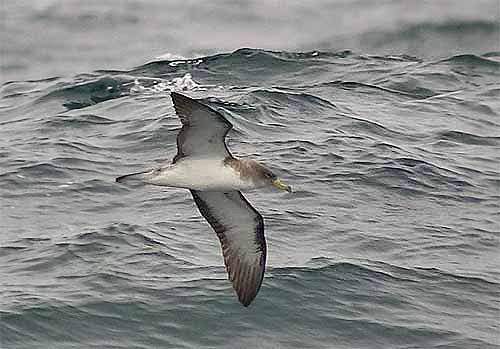 |
| (Atlantic) Cory's Shearwater: Scilly pelagic, Scilly Classic Cory's 'scooped-out' pattern in the underwing, where white underwing coverts meet dark primaries. Even here, the bird seems to show some pale on the inner webs of primaries, which is apparently not uncommon in Cory's (photo: Ben Lascelles). |
2. Size and flight style
Evening flight lines of Scopoli's returning to their colony look similar to the migration flight mode of Cory's as seen off Britain and Ireland, as I watched in a fresh wind, c. Beaufort force 4–5). What is distinctive is that most birds show more flapping flight than Cory's with regular bursts of 5–7 flaps between glides. This is more like Great Shearwater, which regularly has around 7 flaps in a sequence between glides. On occasions I would watch one bird and imagine I was on a seawatch in Britain and follow it continually until it was lost from view. This enabled me to see the whole flap/glide pattern. At first glance some only did a 2–3 flap sequence followed by a glide, just as typical Cory's. However if I persisted, there would nearly always be bursts of 5–7 flaps in one sequence before the next glide. Time and again each individual would, at some stage of passing, break into 5–7 flap sequences. This would be atypical for Cory's and would seem to be a helpful component in looking for Scopoli's. Cory's seem nearly always to average around 3 flaps before gliding again.
The exception in the Mediterranean Scopoli's were fishing birds, which, when in relaxed, circling 'going nowhere' flight, would resort to a 3-flap-only routine. I expect this would be similar with birds following boats and feeding, as opposed to those seen on seawatches in migration flight. I simply could not assess whether Mediterranean Scopoli's were smaller looking than Cory's, but they did feel thinner-winged and with the 'flappy-flight' lacked the slower, lumbering feel of Cory's.
3. Upperwing pattern
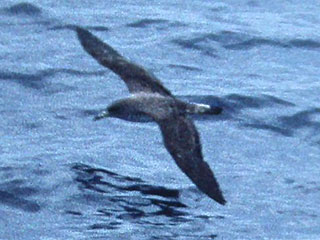 |
| (Atlantic) Cory's Shearwater: Tenerife (photo: Ian Lewington). |
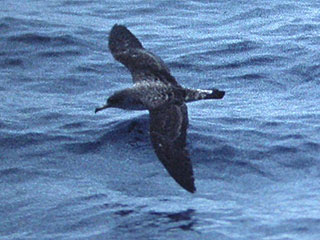 |
| (Atlantic) Cory's Shearwater: Tenerife Typically Cory's upperwing, tends to look mostly dark contrasting with paler upper body (photo: Ian Lewington). |
At a distance, the upperwing on Scopoli's would often appear to show a wholly paler brown inner half of the wing (same as upper body colour), contrasting with uniformly dark outer wing. On close views, there was often a dark isolated band across a pale inner wing. The whole effect was of a paler patterning and more conspicuous dark band than I expect to see in Cory's, which generally show a more extensively dark inner wing, with less 'pattern' visible. It is difficult to know how consistent or useful such a feature might be. The appearance of the upperwing in shearwaters is notoriously affected by light conditions and also by moult. My best guess is that, were a Scopoli's to appear in a stream of Cory's off Britain or Ireland in August, providing the light was flat and overcast, it would show a paler inner wing with more obviously contrasting dark carpal bar than on the Cory's (in which the inner wing would look mostly dark).
A new opportunity for the future?
The ideal scenario for advancing the identification of these birds is to see them side-by-side at close range with prolonged or repeated views, and in a variety of wind and lighting conditions. Until now that scenario has eluded us. However a window of opportunity may have opened up as detailed below. Pioneers of identification may well want to get their tickets booked for the pelagic season into the Bay of Biscay next August and September 2006! If Lee and Terry's observations are repeatable, this could provide the much-needed breakthrough on identification perspectives and occurrence patterns for these birds.
Scopoli's Shearwaters, Bay of Biscay 6th September 2005 by Lee Gregory
On 6th September 2005, travelling south on the Pride of Bilbao passenger ferry on Day Two of a mini cruise from Portsmouth to Bilbao and back, to watch seabirds and cetaceans, Terry Stopher and I observed about 30 Scopoli's Shearwaters (Calonectris diomedea diomedea) in small groups of between 2–4 birds as we headed south.
We had already had an excellent day and the birding was hotting up the further south we went. Highlights so far had been 4 Balearic Shearwaters, several Manx Shearwaters, 6 Sooty Shearwaters, 110+ Great and 30+ Cory's Shearwaters (Calonectris diomedea borealis), 2 Sabine's Gulls, and Storm Petrels. Also some nice cetacean sightings including Common and Bottle-nosed Dolphins, Harbour Porpoise and a Fin Whale- the latter very unusual north of the Continental Shelf.
The weather was fine with a light, southerly wind and clear skies with the sea very calm. We were viewing from the port side of the ship with the sun behind us, making viewing excellent. The first Scopoli's were seen at 16:10 as we were over edge of the Continental Shelf and heading into deep water. They were with a large group of 200+ Great and 30+ Cory's Shearwater, which were resting on the sea. As we passed the flock a few of the birds took off and flew parallel with the ship. In this small group were 4 Cory's and 2 Scopoli's Shearwaters. They were at a range of about 100 metres. With such excellent light and direct comparison with Cory's Shearwater the size, structural and plumage differences were reasonably obvious.
Over the next four hours until dark as we steamed south into the deep water (3600 metres approx.) we soon lost all Cory's, but continued to see a few Scopoli's as well as good numbers of Great Shearwaters. Also in this deep water, the cetacean activity increased significantly with 44 Fin Whales, 10 Long-finned Pilot Whales and more Dolphins being logged.
Compared to Cory's, the Scopoli's were: much slighter birds with slimmer wings and more pointed wing tips; smaller-headed with slimmer bill as against Cory's heavier-headed thick-necked appearance with chunky bill. The Scopoli's also had a more frantic flight with faster and more flaps between glides compared to Cory's slow, lazy flight. The general impression was very similar to Great Shearwater in size, structure and flight action.
Plumage-wise most of the Cory's seen were quite fresh, bright juveniles with only a few worn, washed-out adults with heavy secondary moult present. In Scopoli's it was the other way round, with mostly worn adults (also in heavy secondary moult) being present and only two fresh juveniles noted.
The characteristic underwing pattern of Scopoli's with the white of the underwing coverts extending onto the black primaries and ending in an acute angle was quite obvious at this range. This was in comparison to Cory's where the white underwing coverts ended in a nice rounded pattern, not extending into the black primaries. Overall the Scopoli's were much greyer in plumage tone with more contrast on the upperparts and with the primaries darker than the forewing and back. This was probably more exaggerated as we were comparing worn adult Scopoli's to fresh juvenile Cory's.
We showed these birds to several other birders on the ferry including three Dutch birders who were quite excited as the Dutch have already split Scopoli's Shearwater as full species. The birders who took an interest (some didn't!) were also happy with the identification.
On the return leg of the trip on the 7th as soon as we left Bilbao heading north (and until dark) we picked up numerous Cory's Shearwaters, some of them forming rafts on the sea but we didn't pick out any more Scopoli's. Interestingly on the crossing we took on 24th–27th August 2004 I saw several Shearwaters on the afternoon of the second day near the edge of the continental shelf, which I now believe to be Scopoli's and I did have suspicions at the time. The views at that time were not the best with some swell, quite windy and far fewer birds to compare them with.
It will be interesting to see if this a regular area that Scopoli's Shearwater are seen in, but they are worth looking on for on the whole crossing as I am sure they are under recorded (Lee Gregory, Thetford, Norfolk).
One final note. Check out: 'The Seabird Osteology Pages' on the web for some great coverage of the Calonectris shearwaters, including skull photos and measurements: http://www.shearwater.nl/.
Acknowledgments: Thanks especially to Lee Gregory and Terry Stopher, for writing up their experience, and for Killian Mullarney for lively discussion on the subject.


